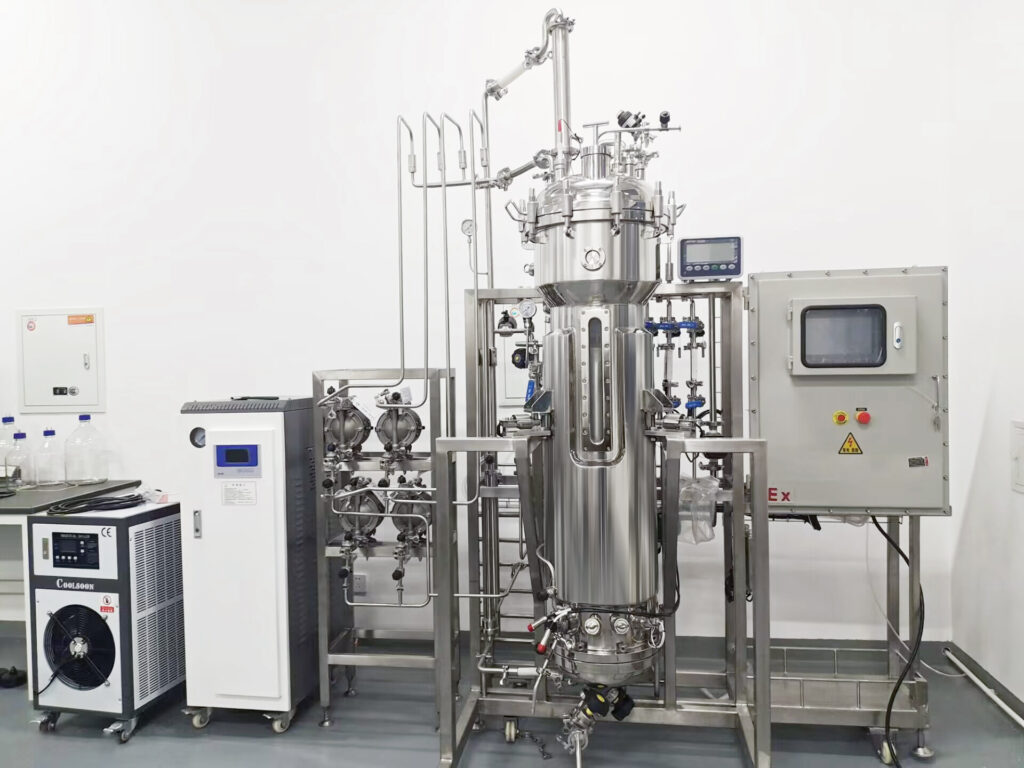Airlift bioreactor is a common suspended cell culture bioreactor, which works on the principle of achieving gas-liquid mass transfer through the rising movement of bubbles.The airlift bioreactor is the most widely used bioreactor. The airlift bioreactor is developed on the basis of the bubble column reactor. The airlift bioreactor uses the jet function of air and the difference in fluid density to cause the reaction liquid to circulate, so as to achieve the stirring, mixing and oxygen transfer of the liquid. That is, without mechanical stirring, it completely relies on the gas to cause the liquid to circulate and generate turbulence, thereby achieving the purpose of gas-liquid mixing and transfer.
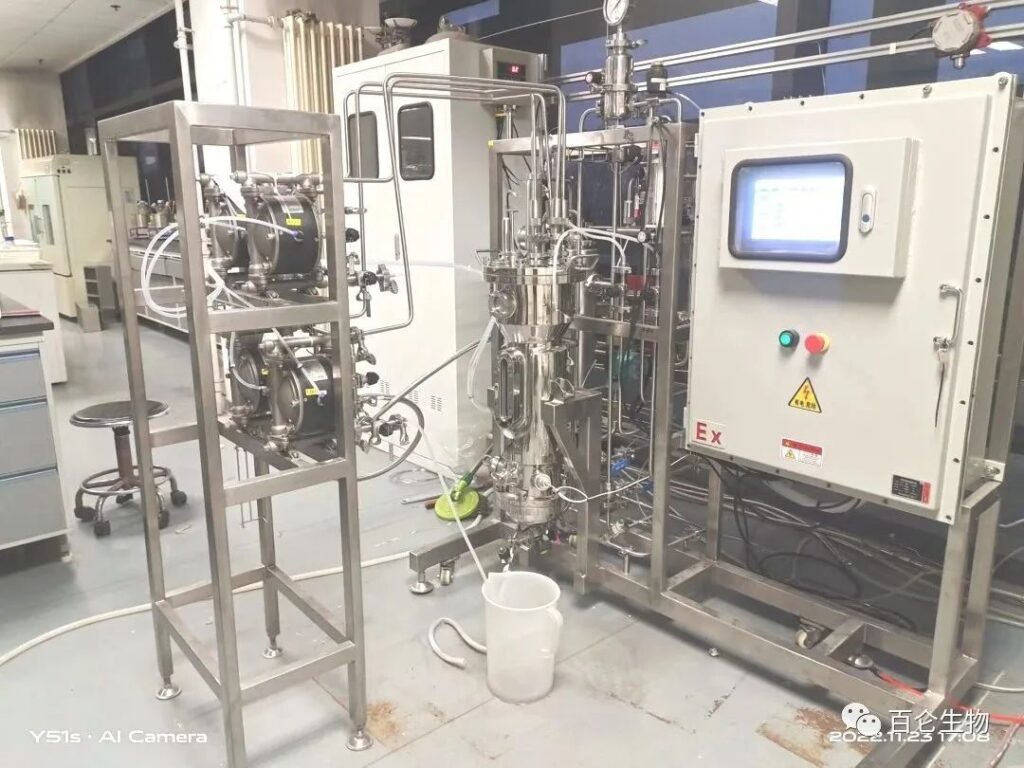
Bailun 10L stainless steel airlift bioreactor BLBIO-10SQ
Compared with traditional stirred tank reactors, airlift bioreactors have better performance and effect in the gas-liquid mass transfer process.Airlift bioreactors have obvious advantages and have been widely used in the production of SCP, filamentous fungi, and wastewater treatment.The structure of airlift bioreactor is relatively simple, does not require stirring, is easy to clean and maintain, is not easy to be contaminated, has low energy consumption, and has high dissolved oxygen efficiency. In addition, the airlift bioreactor has low operating and construction costs. There are many types of airlift bioreactor, the most common ones are airlift circulation type, bubbling type, air injection type, etc. The airlift bioreactors that have been widely used in the bioindustry include airlift internal circulation fermenters, gas-liquid dual injection airlift circulation fermenters, and tower airlift bioreactors with multi-layer distribution plates. The bubbling tank is the most primitive aerated fermenter. Of course, there is no guide tube in the bubbling reactor, so the main directional flow of the liquid is not controlled.
Airlift bioreactors have several significant advantages over stirred tank reactors. First, the airlift bioreactor can provide a larger gas-liquid contact area, increase the gas-liquid mass transfer efficiency, and help fully meet the oxygen needs of cells. Secondly, the liquid flow generated by the movement of bubbles in the airlift bioreactor promotes cell mixing and reduces the difference in the local liquid environment. This is important for uniform growth of cells and uniform distribution of products. In addition, the airlift bioreactor reduces the shear force and mechanical stress that cells receive, which is beneficial to cell growth and the stability of biological reactions.
However, airlift bioreactors also have some challenges and limitations. First, the structure of airlift bioreactors is relatively complex, involving key technologies such as gas distribution and pressure control. Second, the selection of bubble size in airlift bioreactors has an important influence on the gas-liquid mass transfer efficiency and cell growth conditions, and requires systematic optimization. In addition, the airlift bioreactors also needs to consider the influence of parameters such as the density of suspended cells, gas intake, and stirring speed in specific operations.
Although there are some technical challenges in airlift bioreactors, it is still a widely used type of suspended cell culture bioreactor. Airlift reactors improve cell growth and the efficiency of biological reactions by optimizing the gas-liquid mass transfer process, providing strong support for the development of biopharmaceuticals, biofuels, and other bioprocesses. In future research, we can further improve the design and operation of airlift bioreactors to meet the culture needs of different types of cells and promote their widespread application in industrial production.
Bailun 100L stainless steel airlift bioreactor 4-way Ventilation BLBIO-100SQ
Structure of airlift bioreactor (ALR)
The airlift bioreactor is a circulation system formed by installing a riser outside the tank, with its two ends connected to the bottom and top of the tank respectively. Since airlift bioreactor has no stirring device, it is easier to maintain a sterile state for a long time.The airlift bioreactor realizes air circulation through the static pressure difference between the rising liquid and the descending liquid to ensure good mass transfer effect, while making the shear force distribution more uniform and promoting the periodic movement of culture medium and cells in a shorter mixing time.
At present, internal circulation airlift bioreactor have been widely used in aerobic fermentation in the field of bioengineering, such as the cultivation of animal and plant cells, the cultivation of single-cell protein, the cultivation of certain microbial cells, and sewage treatment. The products produced by this include single-cell protein, alcohol, antibiotics, biosurfactants, etc.
Our country has produced a large number of biological preparations using bioreactors, most of which use airlift cell culture bioreactors. Airlift cell culture bioreactor is the abbreviation of airlift bioreactor.
Airlift bioreactors can be divided into internal circulation airlift bioreactors and external circulation airlift bioreactors according to the different liquid circulation methods they adopt.The internal circulation airlift bioreactors sets the riser and downcomer in the circulation process inside the same fermenter; while the external circulation airlift bioreactors sets the riser and downcomer separately.
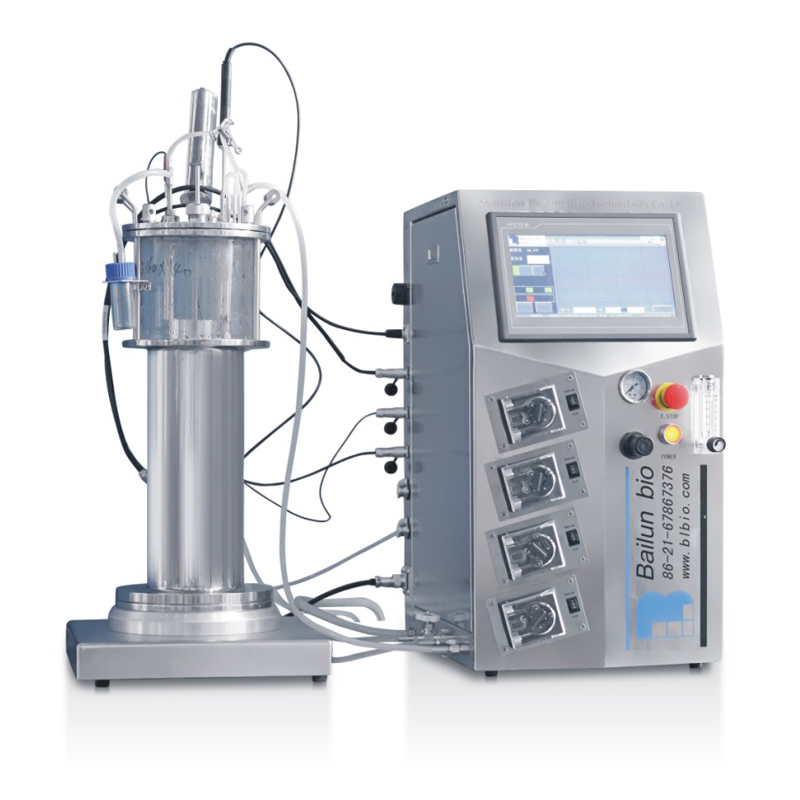
Bailun 5L off-site sterilization glass airlift bioreactor BLBIO-5GQ
Airlift bioreactors mainly use internal circulation, but they also use external circulation. There are four components inside the internal circulation airlift bioreactor:
(1) Lifting fluid In the center of the airlift bioreactor, inside the draft tube. If air is injected at the bottom of the draft tube, due to the static pressure difference between the fluid inside and outside the tube, the gas-liquid mixed fluid rises along the tube, separates part of the gas at the upper part of the airlift bioreactor, and then descends along the downcomer, forming a circulation flow. If air is injected at the bottom of the downcomer, the fluid circulation direction is exactly the opposite.
(2) Downcomer zone The annular gap between the draft tube and the reactor wall. The fluid rises or descends along the downcomer zone, depending on the position of the injected air.
(3) Bottom The area where the lifting zone and the lower part of the downcomer zone are connected, which has little effect on the airlift bioreactor characteristics.
(4) Top The area where the lifting zone and the upper part of the downcomer zone are connected. A gas-liquid separator can be installed at the top to remove the liquid entrained in the exhaust gas.
In addition, the device is also equipped with an annular tube gas injector, etc.
The application of airlift bioreactor in the field of biotechnology is mainly fermentation, wastewater treatment and biological cell culture. Due to the high viscosity, in order to increase the mass transfer rate, mechanical stirring tanks were often used for fermentation broth and biological cell culture broth.
In fact, as long as the appropriate polymer is added to the medium, the use of airlift bioreactors can not only enhance mass transfer and increase production, but also reduce energy consumption.
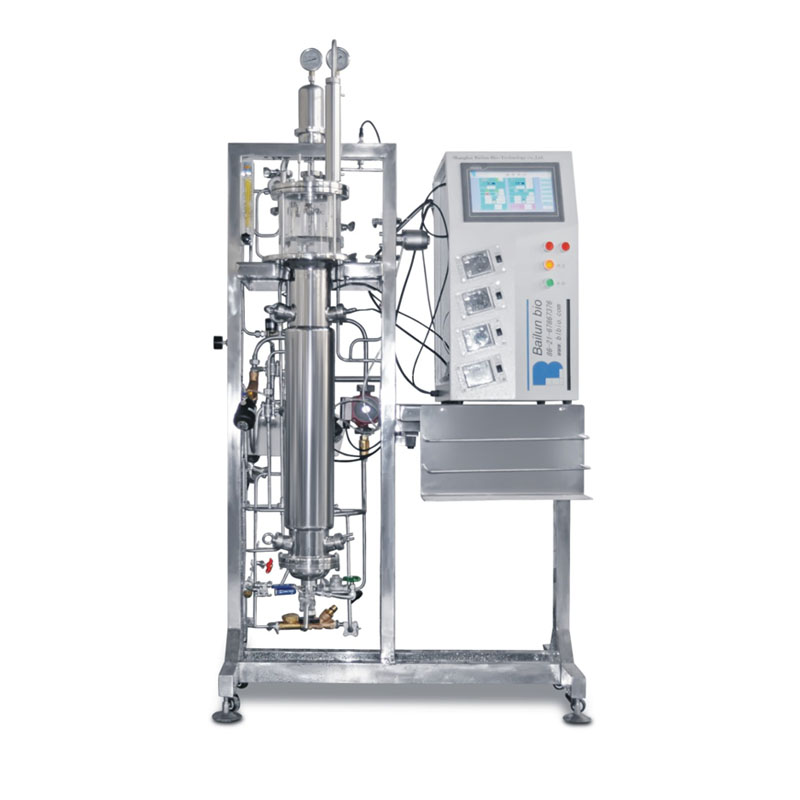
Bailun 5L On-site sterilization glass airlift bioreactor system BLBIO-5GQA
In addition to the advantages and challenges mentioned above, there are some other features and precautions of the airlift bioreactor that are worth adding.
(1)Control bubble size and generation rate: The size and generation rate of bubbles have an important impact on gas-liquid mass transfer and cell growth. Larger bubbles increase the shear force on cells, while smaller bubbles may lead to insufficient gas-liquid mass transfer. Therefore, in the airlift bioreactor, the size and generation rate of bubbles need to be reasonably controlled to balance the mass transfer effect and the shear force on cells.
(2)Control bubble point height: The bubble point height refers to the rising end point of bubbles in the gas-liquid mixed shower layer. The control of bubble point height has an important impact on gas-liquid mass transfer and cell growth. If the bubble point height is too high, the cells cannot fully contact the bubbles, and the mass transfer effect is poor; if the bubble point height is too low, the shear force on the cells will increase. Therefore, in actual operation, the bubble point height of airlift bioreactor needs to be reasonably controlled according to the specific cell type and culture requirements.
(3)Reduce liquid level fluctuation: In the airlift bioreactor, the liquid level will fluctuate during the rising process of bubbles. Excessive fluctuation may cause cell detachment and damage at the gas-liquid interface. Therefore, corresponding measures need to be taken to reduce liquid level fluctuation. For example, the fluctuation of the liquid level can be reduced by increasing the height of the reactor, adjusting the airflow velocity, or using a feedback control system.
(4)Optimizing the reactor structure: In view of the characteristics and needs of the airlift bioreactor, researchers are constantly optimizing the design of the reactor structure. For example, the internal configuration and shape of the airlift bioreactor are designed to promote the uniform distribution of liquid flow and the upward movement of bubbles, and to improve the gas-liquid mass transfer efficiency and mixing effect. At the same time, the operation of the airlift bioreactor can also be optimized and adjusted by means of fluid mechanics simulation and experiments.
(5)Multistage airlift bioreactor: In order to further improve the mass transfer efficiency and cell growth of the reactor, a combination of multistage airlift bioreactors is sometimes used. Multistage airlift bioreactors are usually composed of multiple airlift reactors in series, each reactor is responsible for a specific culture stage. In this way, higher cell density and product yield can be achieved.
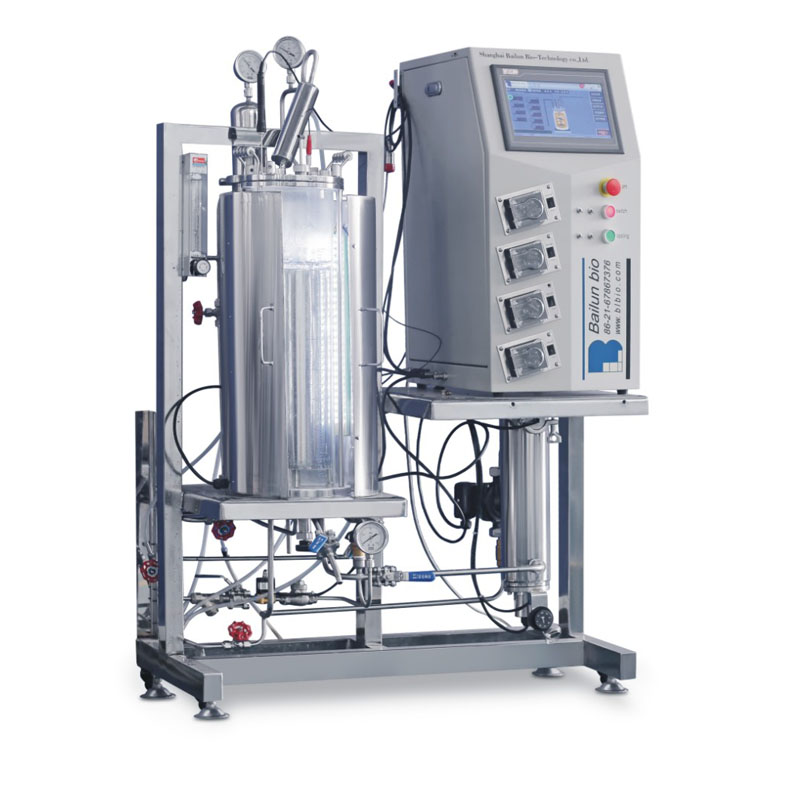
Bailun 15L Off-site sterilization air-lift light bioreactor BLBIO-15GQL
Airlift bioreactors are widely used in the field of bioengineering, especially in the fields of biopharmaceuticals, biofuels and wastewater treatment. The following is a supplement to some specific applications of airlift bioreactors in these fields:
(1)Biopharmaceuticals: Airlift bioreactors are widely used in the field of biopharmaceuticals for cell culture and recombinant protein production. Among them, the production of recombinant proteins has high requirements for cell density and product quality. Airlift bioreactors can provide good gas-liquid mass transfer and cell mixing effects, and maintain good cell growth while increasing production.
(2)Biofuels: Airlift bioreactors can be used for biomass energy production from algae. Algae have a high growth rate and a high oil content. Through photosynthesis, carbon dioxide can be converted into fatty acids. Cultivation and treatment in airlift reactors can achieve efficient growth of algae and extraction of oil, which can be used to produce biodiesel or biogas, etc.
(3)Wastewater treatment: Airlift bioreactors can be used in biological treatment units in wastewater treatment processes to treat wastewater containing pollutants such as organic matter, nitrogen, and phosphorus. The airlift bioreactor provides a larger gas-liquid contact interface, promotes microbial metabolism and biochemical reactions in wastewater, and achieves the purpose of wastewater purification and resource utilization through microbial degradation and transformation of pollutants.
(4)Bioceramics: Airlift bioreactors are also used for the preparation of bioceramics. Bioceramics are a type of ceramic material with specific properties and structures prepared by biological intervention, using the activity and material synthesis ability of organisms. By properly regulating the atmosphere and culture conditions in the reactor, the metabolic pathways of bacteria can be controlled to promote the biosynthesis and deposition of ceramic materials. The airlift bioreactor provides good gas-liquid mass transfer conditions and mixing effects, which helps bacteria synthesize and deposit ceramic materials during the culture process, thereby obtaining bioceramics with good properties and structures.
Sobre Bailun
Bailun tiene una amplia experiencia en la fabricación de diversos biorreactores y recipientes a presión. Cuenta con un equipo de expertos en los campos de reacción biológica, tecnología de fermentación, fabricación de maquinaria y control de automatización. El nivel de procesos e investigación científica está siempre al nivel líder nacional e internacional de primera clase, brindándole una experiencia de producto cómoda, segura y protegida.
Contáctenos:
Dirección: 6848# Liuxiang Rd., Jiading, Shanghai, China
Persona de contacto: Maddie
Correo electrónico: [email protected]
Teléfono:+86-134-7276-8163 (WhatsApp)
Sitio web: https://fermentorchina.com/

